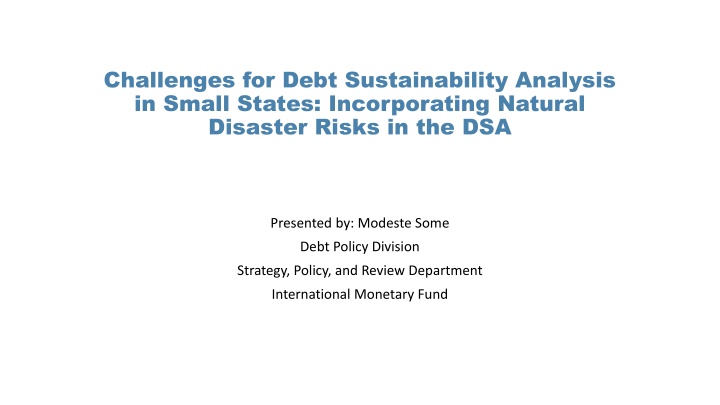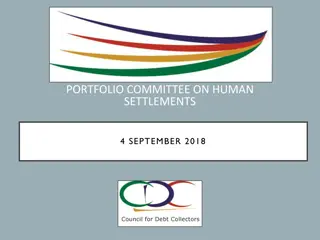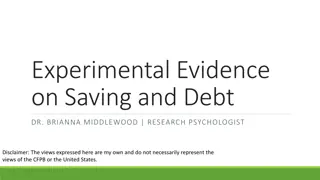Challenges in Debt Sustainability Analysis for Small States
Small states, especially those with populations below 1.5 million, face higher debt vulnerabilities, exacerbated by natural disaster risks. Incorporating climate/disaster risk analysis is crucial for assessing debt sustainability in these states, which often have narrow economic structures and rely on grants. Sustainability judgment is key, requiring consideration of debt burden indicators, breaching benchmarks, projecting grants realistically, and addressing challenges in assessing sustainability, particularly in the face of climate change impacts.
Download Presentation

Please find below an Image/Link to download the presentation.
The content on the website is provided AS IS for your information and personal use only. It may not be sold, licensed, or shared on other websites without obtaining consent from the author.If you encounter any issues during the download, it is possible that the publisher has removed the file from their server.
You are allowed to download the files provided on this website for personal or commercial use, subject to the condition that they are used lawfully. All files are the property of their respective owners.
The content on the website is provided AS IS for your information and personal use only. It may not be sold, licensed, or shared on other websites without obtaining consent from the author.
E N D
Presentation Transcript
Challenges for Debt Sustainability Analysis in Small States: Incorporating Natural Disaster Risks in the DSA Presented by: Modeste Some Debt Policy Division Strategy, Policy, and Review Department International Monetary Fund
IMF Definition of Small States IMF Definition of Small States Countries with a population below 1.5 million that are not advanced market economies or high-income oil exporting countries: 34 IMF members Of which 20 are using the LIC DSF (the focus in this presentation) and the rest are using the MAC DSA. The vast majority are small islands developing states (SIDS) by the UN
1. Small states have higher debt vulnerabilities than the 1. Small states have higher debt vulnerabilities than the average LIC average LIC Small State LICs: higher share of high- risk cases Risk ratings in LICs have been worsening before the COVID-19 shock Evolution of Risk of Debt Distress Evolution of Risk of Debt Distress (In percent of total number of SS LICs with DSAs) (In percent of total number of LICs excluding SS with DSAs) Source: LIC DSA database * As of end-December 2020
with significant challenges in assessing sustainability with significant challenges in assessing sustainability Specific challenges in Small States General guidance on sustainability Sustainability is fundamentally a matter for judgment (high risk rating unsustainable). The LIC-DSF GN covers general considerations: High volatility due to narrow economic structure: how to assess? Standard time horizon may not capture risks (resource depletion, loss of grants, climate etc.) Whether debt burden indicators are at high levels and continuously rising. Whether breaches of benchmarks are significant (in magnitude) or sustained (beyond four to five years); cover both debt stock and debt service indicators; and only turn-around after some time. Projecting grants: LIC DSF cannot assume a level that would not result in grants. (Donor consultations needed.) Regional consistency accounting for natural disaster risks. [e.g., Caribbean countries use similar baseline assumptions]. Whether the projected debt path is one in which we have strong confidence (thus the importance of realism tools).
2. Incorporating climate/disaster risk is critical 2. Incorporating climate/disaster risk is critical Small States are far more vulnerable than other countries to natural disasters which are more frequent and cause considerably more damage.
3. IMF Staff Account for Natural Disaster Risks in the 3. IMF Staff Account for Natural Disaster Risks in the DSA: Baseline + Triggered Stress Tests DSA: Baseline + Triggered Stress Tests New feature in the upcoming update to the DSA for Middle Income and Advanced Economics (SRDSF, old MAC DSA): triggered natural disaster stress test One-off shock to public debt of 7 percent of GDP; Real GDP growth lowered by 5 percentage points in the year of the shock Triggered stress test for LIC DSF countries One-off shock to public debt of 10 percent of GDP in the second year of projection; Real GDP growth lowered by 1.5 percentage points in the year of the shock Nominal growth of exports is lowered by 3.5 percentage points in the year of the shock. Users can customize default parameters to account for country specificities (baseline assumptions, recent empirical studies, etc.)
but there are various challenges in practice. but there are various challenges in practice. Calibrating natural disaster stress tests Assessing adaptation measures Netting out the average impact that may already be in the baseline, reflected in average growth and other variables (which itself is difficult to model). Climate-resilient debt instruments (e.g. with hurricane clauses). Modeling these in shock scenarios. Investments in resilient infrastructure Getting the size of the shock right. For LIC DSF countries, the default 10 percent of GDP is based on a backward-looking event analysis that may not properly signal future costs. Immediate cost (debt and debt service) and thus adverse impact on DSA Is the benefit in shock scenarios enough to offset baseline impact? (Depends on how frequent shocks are, and how costly the investment is.) Assessing the probability of the natural disasters and their impact (should it impact risk rating more? Or even sustainability?). Again, data is backward looking and may not capture future well.
4. Natural Disaster Shocks in Small States 4. Natural Disaster Shocks in Small States 7 of 20 small states have used the natural disaster tailored stress test in the new LIC-DSF Grenada, Maldives, Samoa, Solomon Islands, St. Vincent and the Grenadines, Kiribati, and Vanuatu 3 countries customized the shock to be larger than default (10 percent of GDP) & 5 countries customized the interaction between the macro variables for the shock
4. Natural Disaster Shocks in Small States 4. Natural Disaster Shocks in Small States A small state was downgraded to moderate risk of debt distress due to breaches of the PV of debt to GDP ratio under the natural disaster stress test. For cases of high risk of debt distress and in debt distress, the COVID-19 and natural disaster shocks make debt sustainability challenging.
Key messages and policy recommendations Key messages and policy recommendations Policies should focus on building greater resilience to shocks while closely monitoring whether the level of debt remains sustainable. IMF advice: Countries to contain debt, to seek concessional financing, to prioritize expenditures, to maintain fiscal buffers to cope with natural disasters and to improve revenue-raising capacity. The Fund stands ready to meet the needs of small states, including through policy advice, lending and its capacity development and training programs. To weather natural disasters, countries can have recourse to quick IMF financing through the Rapid Credit Facility and Rapid Financing Instruments (Dominica 2015 and Vanuatu 2015 RCF), with no ex-post conditionality.























